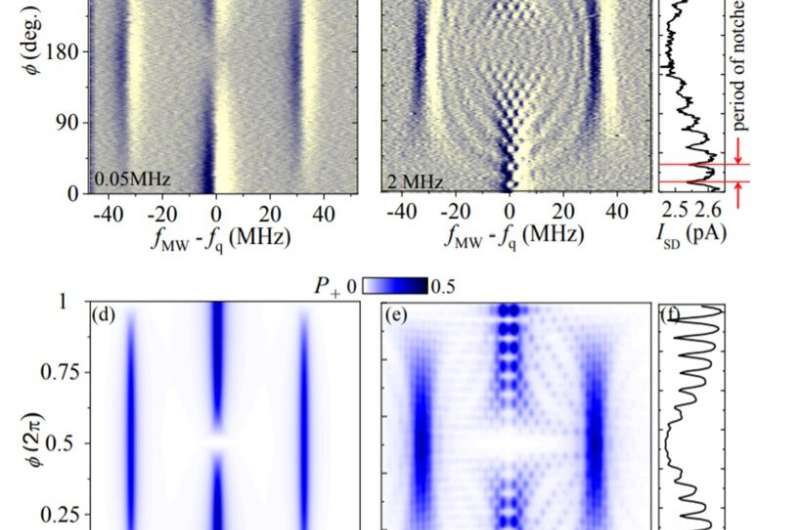October 7, 2020 feature
Quantum heat engine behaviour observed in a qubit

Although many of today's accepted theories of classical thermodynamics predate even the industrial revolution they helped to propel, many open questions remain around how these ideas translate to the level of single quantum systems. In particular, the potential for superposition of states has as yet unexplored implications for thermodynamic behavior. Now, a collaboration of researchers in Japan, the Ukraine and the U.S. has produced a quantum device that can not only behave analogously to a heat engine and a refrigerator, but also a superposition of both at the same time.
Keiji Ono, Sergey Shevchenko and Franco Nori—who share an affiliation with RIKEN in Japan, among their other institutions, B. Verkin Institute for Low Temperature Physics and Engineering and the University of Michigan—had all been working with qubits in various guises. They came together to examine the behavior of qubits based on impurities in silicon for quantum interferometry before turning their attention to how the behavior of these systems might resemble classical heat engines.
Experimental challenges
Exploring thermodynamics at the quantum level opens up some intriguing possibilities. "One of the subjects discussed in this field is the possibility of quantum heat engines to overcome the efficiency of classical ones," Shevchenko suggests as an example. However, it is not without its challenges, which means most studies so far have been purely theoretical. Among other characteristics, for quantum engineering, it is important to have qubits which are "hot, dense, and coherent," Shevchenko tells Phys.org. Here, "hot" means working in the few-Kelvin regime, which, while still pretty frosty, is less technologically challenging than systems that require cooling down to millikelvins. The trade-off is that such hot systems are harder to describe and control, but here, the researchers were able to exploit their wealth of expertise with silicon-based qubits.
Ono, Shevchenko and Nori and their collaborators based their quantum thermodynamics studies on a tunneling field-effect transistor made from densely implanted impurities in silicon. Under source-gain voltages, transport across their device is dominated by tunneling between one impurity near the surface (shallow) and one nearby but deeper within the material, creating a two-energy-level device. The electron transport behavior of the device gives rise to interesting spin characteristics, in particular, an electron spin resonance in which the source-drain current peaks for specific applied AC and DC magnetic fields. From this resonance peak, they were able to extract two characteristic timescales that reflect the lifetime of the excited state on the impurity and its decoherence time. The decoherence time defines how long a definite phase relation is retained between its wavefunction and others, which allows superposition and interference.
As well as being able to drive the device with the gate voltage to populate the two energy levels, the researchers could also adjust the gap between the energy levels by modulating the frequency and amplitude of the magnetic fields. As a result, depending on whether the system was driven to the excited state when the gap was large and relaxed when it was smaller or the converse, it would operate analogously to an Otto heat engine or refrigerator. The interesting quantum effects occur when the relaxation period and the period of the driving voltage start to coincide. At this point, they show that the device function can be in a superposition of both an engine and a refrigerator state. Theoretical calculations of the excitation probability matched the measured peak currents perfectly.
Limits and future developments
There are some distinctions between the operation of their quantum device and a classical heat engine or refrigerator. In particular, there are no heat baths, although their device is connected to higher and lower voltage leads, acting as electric analogs of heat baths. Nonetheless, Shevchenko says, "It is surprising to consider the new possibility of having a quantum superposition of a tiny engine and a tiny refrigerator."
While the first to acknowledge that in the macroscopic or classical case, such a device would not service many practical demands, the researchers hope that for quantum objects it may introduce new functionalities that are not only interesting but also useful. As another example, Shevchenko cites the laser, which was invented long before the now-ubiquitous applications became apparent. "We believe that our results are scientifically interesting," Shevchenko tells Phys.org. "For the time being, we are exploring its basic physics, and [believe] that the possible applications are not clear at this time. This often happens in science."
More information: K. Ono et al. Analog of a quantum heat engine using a single-spin qubit, Physical Review Letters (2020). Accepted manuscript: journals.aps.org/prl/accepted/ … b682605ce40bdae2719c
Arxiv: arxiv.org/abs/2008.10181
Journal information: Physical Review Letters , arXiv
© 2020 Science X Network





















